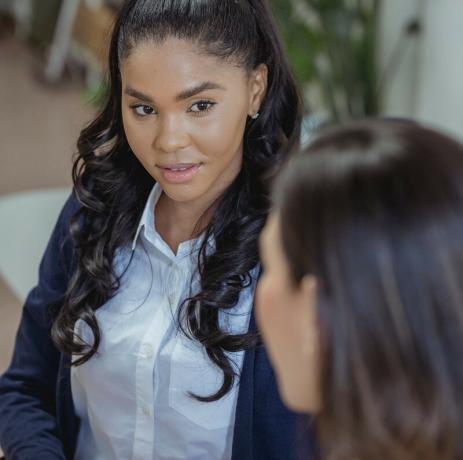5 active listening exercises to train this skill
We usually take for granted that we know how to listen. We consider that by the simple fact of knowing how to speak we also know how to listen and that conversations are mere information-sharing transactions.
Hearing implies receiving sound stimuli, but this does not mean that we fully understand or realize what our interlocutor is saying to us. Either because we get distracted or because we think about other things, they may be telling us things and they just don't come to mind.
Active listening involves not only hearing what they tell us, but also understanding it, retaining it and following the thread of the conversation. This skill can be put into practice and, therefore, below we are going to see a few active listening exercises.
- Related article: "Assertive communication: how to express yourself clearly"
Is it possible to train active listening through activities?
Do you think you know how to listen? Let's see. Here are a few questions and we ask that you please answer them as honestly as possible.
Think about when you find yourself in a conversation with a friend or a relative, a situation in which you have to listen to the other person:- Do you think about your answer while the other is talking?
- Do you suppose what he is going to say before he says it?
- Do you cut him short to give your point of view or to finish his sentences?
- Do you disconnect or get distracted thinking about other topics?
- Do you react impulsively to certain words?
If you have answered yes to more than three of these questions, then we highly recommend that you continue reading.
We define active listening as the ability to listen to the message that our sender gives us, making a conscious and voluntary effort to pay attention, following the thread of the conversation and deeply understanding what he is saying to us. It is not just about hearing the words he is saying to us, retaining them in working memory, but also understanding the complete message.
In order to put this skill into practice, it is necessary to focus our attention on the person with whom we are maintaining a relationship. conversation, avoiding any distractions in addition to trying to formulate arguments against while the other person is still talking. It is not possible to understand everything it tells us if we get distracted thinking about how we are going to replicate it, because by doing so we begin to ignore part of the message that it is trying to share.
Being able to play the role of an active listener requires a lot of concentration and determination. This is complicated, but not impossible, because while breaking old habits is difficult and consciously working on avoiding distractions is a real challenge, getting the maximum attention to who is sharing their thoughts, emotions and opinions is perfectly achievable, as long as we put into practice the active listening.
In general, we can say that the practice of active listening focuses on five aspects to take into consideration:
- Pay real attention
- Show that you are listening
- Provide feedback
- Don't make value judgments while listening.
- Respond appropriately.
Active listening helps us to be better communicators. What's more, By listening better to what others tell us, we are able to create a more positive environment, avoiding misunderstandings and reducing the possibility of uncomfortable situations such as, for example, having to repeat over and over again what they have already told us.
Nobody likes that, after giving his speech, the person who was supposed to be listening to him has not understood absolutely anything of what he has said. Active listening is a show of respect and appreciation.

- You may be interested in: "Active listening: the key to communicate with others"
Active listening exercises to communicate better
Here are five ideal active listening exercises to improve this skill:
1. Viewing a conversation
The first one we present is individual. It may seem strange that there is an active listening exercise that can be done without anyone else, but the truth is that is the best way to practice before finding yourself in a real interpersonal situation in which we need to display good listening skills. This exercise is ideal for doing an active listening drill.
Imagine that you want to tell someone else how you spent yesterday (think about what you did and think about who you want to tell). Once you've decided on the subject and the person, move on. Now, imagine how you are telling it, what details are you dwelling on more because you would like to influence it, what aspects you want to tell in depth.
Let's say that he has been attentive or attentive to what you were telling him during all this time, looking at you and smiling at you, doing gestures according to the information you told them as surprise at unexpected details or sadness at data unlucky. He has left you all the time in the world so that you can explain with hair and signs what you wanted to express to him.
Now we will imagine just the opposite situation. The person shows up very differently, cutting you off every time you say three words and constantly interrupting you. He gives you advice without your asking and even changes the subject and tells you his point of view.
How you feel? What kind of behavior would you prefer?
This is an exercise that, although solo and mental, is very good to put empathy into practice, what other people would feel if we did the same thing that happened to us with the second stage.
2. The bus
The bus game is a classic activity used to break the ice in houses of colonies or workshops of practice of emotions. The slogan is simple, ask attendees to listen carefully to the story that you are going to tell them below and that, at the end, you will ask them a question:
Imagine that you drive a bus. At first the bus is empty. When you get to the first stop, five people get on. At the next stop, three people get off the bus and two get on (Generally, upon hearing this phrase, attendees begin to make mathematical calculations of how many passengers are in the vehicle). Later, ten people get on and four get off. Finally, at the end of the line another five passengers get off "
The question is: What is the foot size that the bus driver wears?
When asking this question, it is normal for listeners to get caught, saying that it is impossible to know the answer. If this is the case, the statement must be repeated again, as many times as the facilitator sees it necessary. until the participants come up with the answer that they will only arrive at if they listen carefully to the exercise.
The answer is actually quite simple (and funny): "You are the bus driver, so you will know what your shoe size is"
3. The blind
Another group activity that we can put into practice is the blind man's game. In this exercise Attendees are divided into two teams, with each team choosing a person from among its members who will act as "blind".
The activity consists of making the blind man, who will be blindfolded, go from one side to the other of the room or field where the exercise is carried out, trying to avoid a series of obstacles such as tables, chairs, mats... In order to avoid them without hurting yourself or colliding, you should be aware of the instructions given to you by your classmates.
The facilitator will time how long it takes each team to get their blind to reach the goal, although this is not really the main objective of the activity. The main objective is to get the person who plays the role of blind to practice active listening, paying close attention to what his colleagues say without being distracted.
4. Selective listening
Another very interesting exercise is selective listening. For this activity we are going to divide the team into two large groups, one A and the other B. Group A will be subdivided into A1 and A2 and we are going to tell you a short story to which you should pay close attention because we are going to ask you for two different slogans.
The story can be whatever it is, and the slogans too, as long as they are different. For example, we can ask group A1 to tell us the number of times we say the word “la”, while we can ask group A2 to tell us how many times we say “one”. An example of history would be the following:
“A long time ago there was a girl in a village with brown hair and a red hood who her mother told her to bring a basket of food. The girl took the basket and went happily through the forest, walking along the path that led to her grandmother's house. On the way, he found a wolf who tried to eat her, but the girl was able to flee from her, arriving at her grandmother's house and giving her her basket because she was very hungry "
While group A1 and A2 are waiting for how many “la” and “una” appear in the story, there is the other group, B. We have only asked this group for one thing: to listen to the story carefully, nothing more. We are not asking you to pay attention to anything specific, just to be attentive while we tell the story.
After we have finished telling the story, we ask questions related to what we just told them. Among these questions we could say "what color was the girl's hair?" or "what was in the basket?" Here we will see differences between groups A and B.
Those of A, who have been waiting for the words that we have told them that they will count, it is quite likely that they have not noticed what the story was about while those of B, which we have only asked them to listen to, will find it easier to answer these questions.
Here we see the differences between doing selective listening, which would correspond to what those in group A have done, and having applied active listening, which would be the case of group B.
5. Tell me your story
This activity is done in pairs. Each of the members will tell the other a story in a summarized way, with a lot of emphasis on details and events that are important and meaningful to those who tell them. Afterwards, each member of the couple will introduce her partner and try to tell the same story that he told her, trying to remember the details and highlights.
Once this first step is finished, having told all their stories, there will be a debate and there will be a round of questions:
- Have you felt that your partner listened and understood you?
- How have you felt when you have told your story and your feelings?
- How did you feel when you had to tell your partner's story and reflect his emotions?
- What has been more difficult: repeat or reflect? Why?
- What is the most important thing to you about the message?
- What do you learn from this experience?
This activity aims to train attention, focusing on what is said and the emotion that accompanies when explaining other people's stories. It also allows us to train our empathy by trying to respectfully explain what others have confessed to us.

